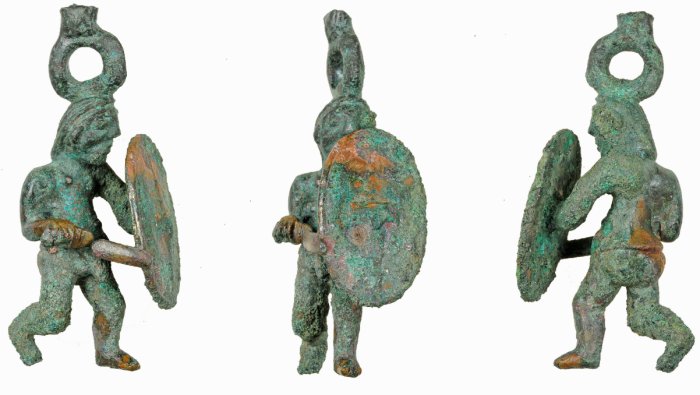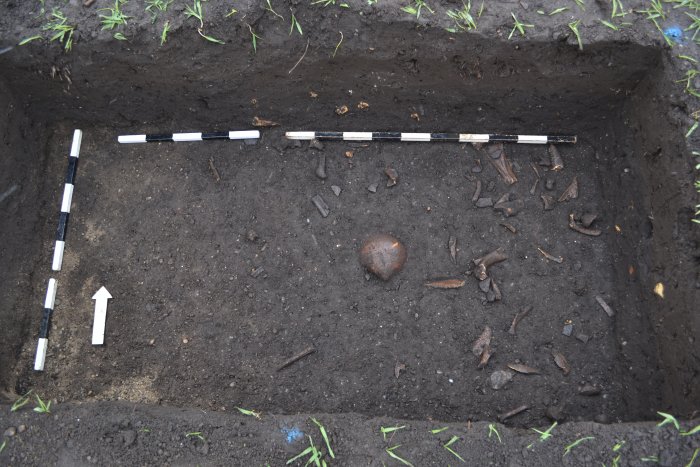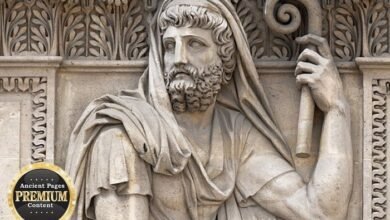Genuine Bronze Warrior Statuette Unearthed At Technologically Advanced Celtic Settlement Oppidum Of Manching

Conny Waters – AncientPages.com – The recent archaeological excavations at the Oppidum of Manching have yielded significant insights into the ethnic group and their cultural practices, with over 40,000 items discovered and 1,300 findings documented. Conducted over a three-year period from 2021 to 2024, these excavations covered an area of 6,800 square meters.
Bronze Celtic warrior statuette. Image source
Oppidum of Manching is an important archaeological site, the remains of one of Central Europe’s most thoroughly investigated Celtic settlements. Among many impressive discoveries is a miniature bronze warrior figurine with its elaborate details and enigmatic symbolism. The artifact invites deeper exploration and understanding.
The bronze miniature figurine, standing at 7.5 centimeters and weighing 55 grams, represents a Celtic warrior deorated with chest armor yet conspicuously unclothed from the waist down.
“This small bronze warrior resembles something from Asterix and Obelix; however, it is genuine.” Unearthed in a trench within the settlement, experts speculate that the figure may have served either decorative or ceremonial functions. Its design suggests it could have been suspended as a pendant due to the presence of a small loop on its head,” said Mathias Pfeil, General Conservator at the Bavarian State Office for Monument Preservation.
The warrior statuette after restoration. Image credit: Bavarian State Office for Monument Preservation.
“The warrior statuette was found in a trench, the findings of which can be dated to the 3rd century BC on the basis of ceramics.,” explained Thomas Stöckl, restorer at the BLfD.
It is a complex and delicate work made with the lost-wax casting method, and it’s not surprising because the Celts’ remarkable metalworking skills are widely known. In this technique, a wax model is embedded in clay, melted away, and replaced with molten bronze, resulting in highly detailed and durable artworks.
First, a detailed model is created from wax is formed, which is then embedded in clay and melted out. The molten bronze is then poured into the resulting cavity. On the head of the figure is located a ring eyelet, which could possibly be used for suspension on a chain, for example.
The settlement started at the end of the 4th century. BC and developed in the course of the 2nd century BC, it became a political and economic center located north of the Alps. With the construction of a city wall around 140/130 BC, the settlement reached its largest expansion with an area of about 400 hectares and offered space for probably up to 10,000 people. In the middle of the 1st century BC, the settlement gradually lost its significance. With the gradual withdrawal of the population, urban life ended.
Findings with remains of at least three human individuals and numerous animal bones. Image credit: Pro Arch Prospektion und Archäologie GmbH.
The site was found perfectly planned with society that was both resourceful and advanced technologically. Theexcavations revesled urban planning that included central squares, streets, workshops, and residential areas. Among the large variety of artifacts, archaeologists mention metal objects, tools, ceramics . The finds deliver evidence of fish consumption, and a varied diet of domesticated animals, grains, and dairy products.
But the recent excavations also raise questions. An outstanding finding, dated to ca. 120 – 60 B.C., makes the archaeologists wonder whether there might be a the ritual context is hidden:
Sebastian Hornung, excavation director of the company Pro Arch Prospecting and Archaeology GmbH., additionally informed that the team also discovered a ritual well, at least three human individuals, numerous animal bones of cattle, pigs and sheep, 32 metal finds and remains of more than 50 ceramic vessels.
In addition to grain products, the residents of the Oppidum also fed by beef and pork, as well as fish. Leftovers became collected in household and slaughter pits. While cattle and pigs were kept mainly for meat production, horses were usually slaughtered only after fulfilling their useful function at an advanced age. Sheep and goats mainly supplied wool and milk. The craft areas in the Oppidum, had workshops for metal processing. Also, the recycling of ceramics, wood and metal was known to the Celts of Manching in order to save resources.
Written by Conny Waters – AncientPages.com Staff Writer







